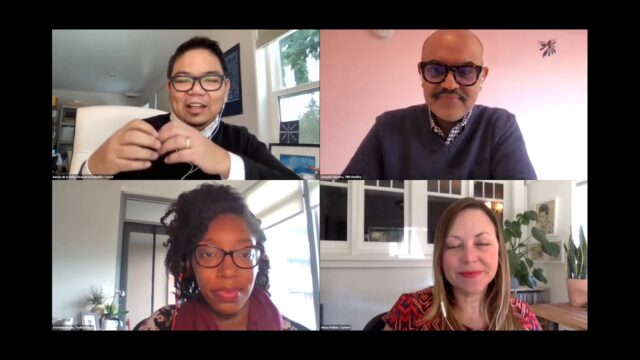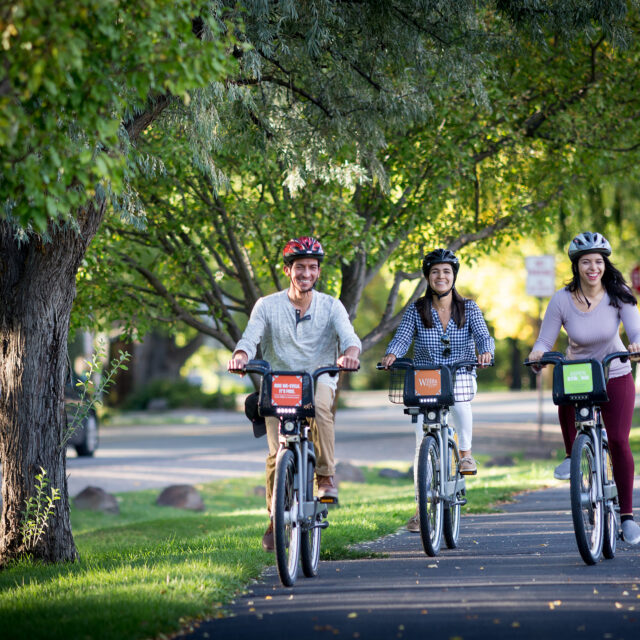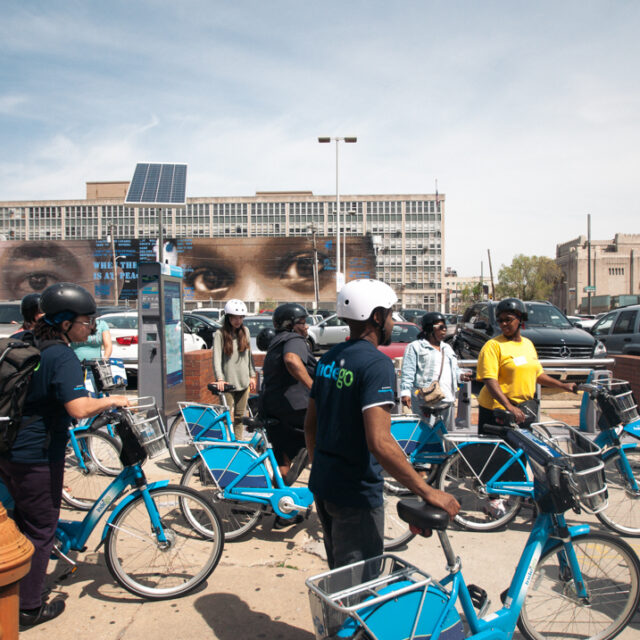Lessons from the 2021 SUMC Conference
by Kiran Herbert, Communications Manager
August 6, 2021
Every Tuesday this past July, the Shared-Use Mobility Center hosted virtual, themed discussions. Here’s 16 learnings we took away from the series.

SUMC’s new CEO, Benjamin de la Peña (upper left), moderated many of this year’s conference sessions.
Dubbed “The Big Shift: Building the Infrastructures of Shared Mobility,” this year’s Shared-Use Mobility Center (SUMC) conference examined how we can shift our current systems towards sustainability and equity. Taking place in four-hour blocks every Tuesday in July (with one-hour echo sessions on Thursdays), each week tackled a different theme, including “Informational & Physical Systems,” “Financial & Funding Systems,” “Policy & Institutional Systems,” and “Social and Political Systems.”
The sessions and discussions put a special emphasis on diversity and building connections in and out of the transportation space. Benjamin de la Peña, who took over as SUMC’s CEO in 2021, has consistently emphasized the role equitable transportation can play when it comes to tackling issues of climate change and social justice, and that theme was carried throughout the conference. By bringing together speakers from a variety of backgrounds and elevating early lessons that scale, participants were galvanized to take actionable steps towards building a better future for our communities and our planet.
Although I wasn’t able to attend all of the sessions, I took copious notes on those that I did, consistently impressed by the quality of the discussions and Peña’s leadership. What follows are 16 of the lessons that stuck with me over the course of the conference, with a particular focus on how we can all organize our work around transportation equity.
1. We need to treat our workers well
We can’t have a mobility justice future if we don’t include working families and our transportation employees in the conversation. Equity extends to the people we serve but it starts internally, with our own organizations and staff.
2. Bringing more voices to the table is just the beginning
We have to create an inclusive atmosphere and provide opportunities for people to speak. Although we should strive to actively listen and take action, equity work is really about sparking community empowerment and self-determined solutions. There’s a temptation to push the latest technology or things we view as breakthroughs, but pushing “community-owned” is what’s truly innovative.
3. Traditional equity measures have failed us because they’re not holistic
We need to expand our minds beyond “access” and “affordability,” reimagining organizational structures and our decision making processes. Before investments are made, we need to establish people-centered plans. Hana Creger, the senior program manager of climate equity at the Greenlining Institute, shared a helpful (and relatively simple) Mobility Equity Framework for anyone that wants guidance on how to make transportation work for people.
4. Prioritize people over profit-making
Money might run our world, making profit is a necessary aspect of enterprise, but transportation needs to be about more than dollars. What’s truly important is seeing communities—and historically marginalized groups in particular—thrive.
5. Learn to work with the “Fast and the Furious” crowd
Car culture isn’t going anywhere and it’s unfair to say historically marginalized groups don’t get to participate in the (extractive) practices that the privileged have enjoyed for decades. It’s important to check our own privilege, not own the narrative of “what needs to happen,” and collaborate with those who have strong identities rooted in cars and driving.
6. Don’t bet on technology to solve your problems
There’s a lack of diversity when it comes to the technology sector and we run the risk of perpetuating inequity if we rely on systems that haven’t engaged all user groups from the get-go. There’s no substitution for good community engagement.
7. Equity is a current that should run through your entire organization
It’s important to consider how everything from our budgets to how we interact with the public advances equity. Who are we hiring as contractors? Is there diversity in all levels of our organizations, or do we see a differentiation between frontline and office-based workers or leadership and entry-level staff? What does your talent pipeline look like? Your workforce needs to represent leadership which needs to represent the community you serve.
8. “Staying in your lane” doesn’t apply to equity work
Things like affordable housing, unemployment and hunger are inextricably linked to transportation. You might want to talk about bike lanes, but sometimes it’s important to first discuss neighborhood crime. Mobility is part of a more complex system, it’s not just about moving people and goods through a city. We’ll achieve little if we insist our employees and the people we serve only engage in a limited agenda.
9. Availability is not the same as access
You can put a bike share system in any neighborhood but it doesn’t matter if the people there don’t know how to ride.
10. Use your product
Whether you work in transit or bike share, you’ll never understand your customer’s experience if you’re not regularly experiencing the mode yourself.
11. Don’t operate in a silo
Agencies need to work together so that we have a holistic mobility lens—it’s not just about what’s good for one department, it’s about what’s good for our communities. As an organization, you will occasionally have to help folks understand how things benefit the greater good—while continually examining your definition of that good.
12. Leaders need to have courage
Be bold with your vision and buck the status quo, speaking up for all those who aren’t currently present. I love this quote from Hillsborough Area Regional Transit Authority CEO Adelee Le Grand: “You don’t need to be on a kamikaze mission all the time but if you’re sitting at the table, you need to have courage.”
13. Engage the youth
It’s important to bring a diversity of people to the table—immigrants, low-income people, you name it—but equally important are our middle schoolers and teenagers, who will be adults by the time many projects come to fruition. The youth are our future and engaging them from an early age is paramount.
14. Constantly take time to reflect
Any project is a vision of the future, so it’s important that we be intentional when we’re designing things and who we’re designing them for. Simply taking the time to acknowledge who your plans will serve and who they won’t is an important first step in ensuring no one gets left behind.
15. Dream big but nail the details
We all strive to serve a large subset of people but it’s important to show folks what’s possible when we do one thing really well. Nevertheless, we have to create grand, audacious goals and communicate them effectively—we’ll never arrive at the future we want if we’re scared to envision it aloud.
16. There is no end point for equity
We’re just getting started and it requires us all to constantly be reevaluating our overarching mission and goals. Imagine we’re all on a multi-use path—make room for all modes, invite others along, pay attention to where you’re going and above all, keep moving forward.
The Better Bike Share Partnership is funded by The JPB Foundation as a collaboration between the City of Philadelphia, the National Association of City Transportation Officials (NACTO) and the PeopleForBikes Foundation to build equitable and replicable bike share systems. Follow us on Facebook, Twitter and Instagram or sign up for our weekly newsletter. Got a question or a story idea? Email kiran@peopleforbikes.org



